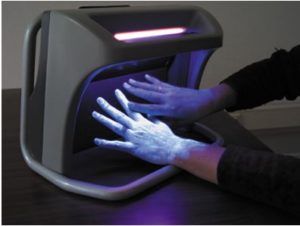From UV-lamps through black boxes to the Semmelweis Scanner
In our previous posts, we described what the fluorescent trial is, and when it should be applied. The conclusion was that the fluorescent trial is a quick and cost-effective solution, it is microbiologically validated, and these facts make it a great educational tool. Once we decided that it is a method for us to apply, what are the commercially available solutions? How do these systems differ in availability, capabilities and price?
The minimal requirements for the fluorescent trial are a UV-lamp and fluorescent dye containing ABHR (alcohol-based handrub). We previously summarized some of these ABHRs, and they are not much more expensive than normal ABHRs. The cost of the UV-lamps varies between 10-300 EUR, depending on the power, wavelength, etc. Some suppliers offer starter kits under 100 EUR, as shown in Figure 1.

Figure 1: Examples of basic starter kits for fluorescent trial. A: Glow Germs mini kits,
B: Glowtec Wash&Glow training kit, C: GermJuice hand washing training kit.
The next item – most of the suppliers offer – Is a so called “black box”; a rigid case that can help to shut out normal light. (So that you do not needed to turn off all light during inspection, making the whole process more convenient.) Some of these “black boxes” are shown in Figure 2. Just a side note, the product of BBraun – literally called BlackBox – is discontinued. The price of these setups are usually around 200-300 EUR.

Figure 2: ‘Black boxes’. A: BBraun – BlackBox, B: Hartmann – Derma LiteCheck Box,
C: GlitterBug –Disclosure Center Starter Kit, D: Ecolab – KlerReveal Operator Training Kit,
E: DaRo UV Systems Ltd. – Hand Inspection Starter Kit.
The above-mentioned setups cannot record any results. Auditors provide a verbal assessment to the users, based on their judgement, or draw the missed parts of the hands on paper. The next step was to attach a digital camera to the box. It allows to record pictures under the fluorescent light, which makes the whole process more objective. Figure 3 shows the Dermalux Checkbox, which costs more than 1000 EUR.

Figure 3: Dermalux – Checkbox Multimedia.
Up to this point, only manual inspection was feasible, even if pictures were recorded. As we previously discussed, auditors can rarely remain independent, that is called the observer bias. Manual inspection is labor intensive, therefore it is expensive and slow. The idea to digitally analyze recorded pictures is not new. Turner et al. 1994 described an image analysis process for the measurement of handwashing effectiveness. They concluded that once system is set up, costs for subsequent use are negligible. More than twenty years passed since, digital technology became cheaper and more reliable, and some new experimental settings were documented in the literature. A couple of them are shown in Figure 4. These systems are not commercially available.

Figure 4: Experimental setting can digitally analyze hand recordings.
A: Szilagyi et al 2010: Stery-hand system, prototype of the Semmelweis Scanner
B: Smieschek et al. 2016
Complex systems cost an order of magnitude more than a simple black box with a camera, yet they far exceed their capabilities. Complex systems have several advantages, such as objectivity, repeatability of measurements, unique identification of staff, etc. Their main feature is the capability to support continuous quality monitoring. The finest example is Semmelweis System (Figure 5), which has two main components:
- the Semmelweis Scanner that records and analyzes the recorded pictures, and
- the Reporting System, where statistics – either individual or ward level – are available online, providing real-time data about hand hygiene status and progress. This feature plays a key role in long-term hand hygiene development, and help to track behavioral change, and ensures that consistent quality hand hygiene is being upheld.

Figure 5: Semmelweis System. A: Semmelweis Scanner, B. Reporting System.
Conclusion:
There are several solutions for applying the fluorescent trial from cheap gadgets to major IT systmes. The more complex a system is, the less human resources is needed to operate it. Complex solutions can record more hand hygiene events with less effort. Large-scale, continuous assessment is only feasible with digital, automated systems.
Read our previous post about the microbiological validation of the fluorescent trial. Please stand by for our next blog entry, a summary of the electronic compliance monitoring systems.